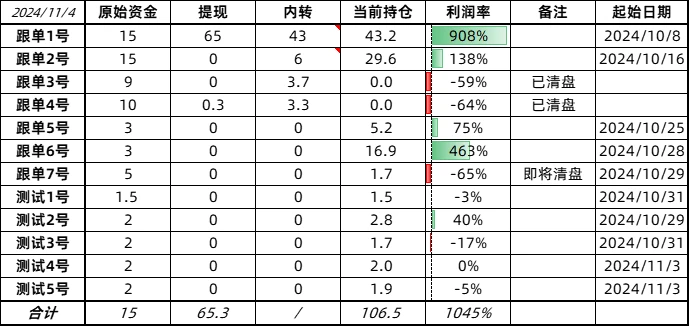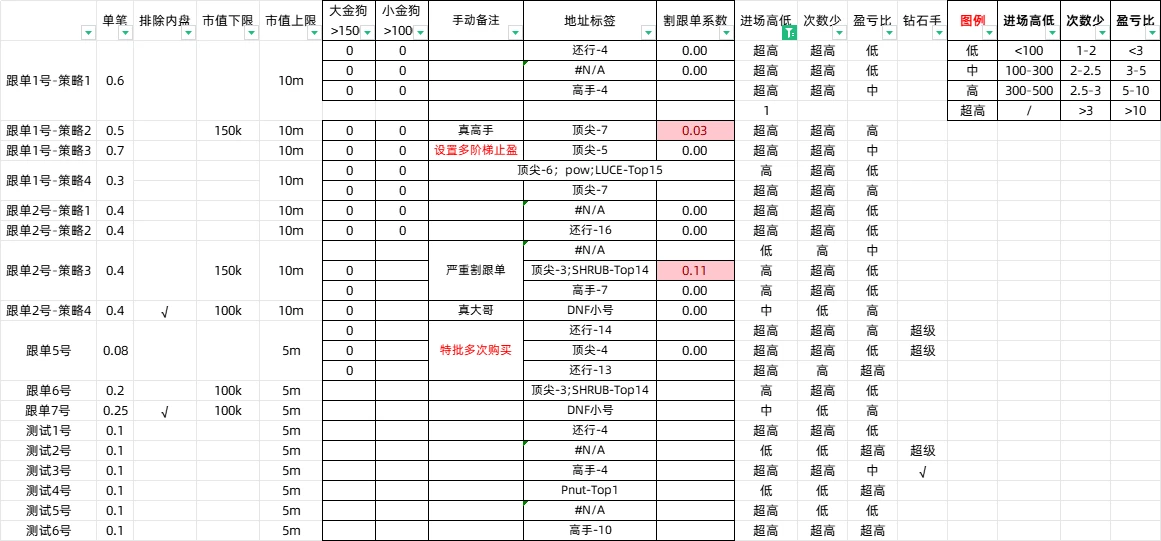Original | Odaily Planet Daily (@OdailyChina)
Author | Nan Zhi (@Assassin_Malvo)

Last week, after introducing the Deep Evaluation System, the stability of Copy Trading No. 1 and No. 2 significantly improved, starting to provide continuous financial support for other test accounts, and Copy Trading No. 6 achieved nearly five times growth in a week.
In this article, the author will update the progress of each wallet, display the tracking charts of the copy trading addresses, and update the upgrade status and future plans of the Deep Evaluation System.
Risk Warning: This system has been operational for only 28 days since its launch on October 8. Although certain results have been achieved, from an objective perspective, the data volume and comparative experiments are insufficient, and the rigor is limited, for reference only.
Funding Progress and Strategy Display
As of November 4, 17:30 (UTC+8), the funding status of each address is shown below. Each account has different profit capabilities and growth curves based on the style and strategy of the copy trading targets. Among them, Copy Trading No. 6 achieved nearly five times growth under certain special circumstances, with specific details provided in the next section.
This section will further showcase specific copy trading plans and the author's thought process during this process.

The tracking details of the copy trading targets are shown in the figure below, where
The left column is the strategy column, set differently based on the wallet's profitability, purchase frequency, and internal trading profitability.
The middle section is the feedback from practical results and preliminary evaluation system labels.
The right column contains labels based on the Deep Evaluation System (I), with label classifications as shown in the legend in the upper right corner.
(Note: For the reasons behind the left column settings, see “Diamond Hands, High Profit and Loss Ratios? What Are the Winning Factors in Solana Meme Trading?” and “Meme Cultivation Manual: Rebirth to Become a Diamond Hand (Part 2)”. For the right column, see “Meme Cultivation Manual: Rebirth to Become a Diamond Hand (Part 3)”.)

Brief Overview of Copy Trading Strategies
Copy Trading No. 1 and No. 2 are early selected low-frequency, high profit and loss ratio, diamond hand addresses, and addresses with high drawdowns were removed based on the guiding principles of the third article. The results after removal appear acceptable so far, with No. 1's profit rate rising from 725% to 908% over six days, and No. 2's profit rate rising from 84% to 138%.
Copy Trading No. 5 is an extremely low-frequency (only 11 purchases to date), high profit and loss ratio, extremely diamond hand address. These addresses have historically succeeded in high-level accumulation, making it the only address open for multiple purchases, with a reduced single purchase amount. However, due to the limited total number of transactions, there is currently no summary of its impact on the system's profitability.
Copy Trading No. 6 and No. 7 originally copied the addresses that gained the most high-multiple tokens from No. 1 and No. 2 (the Elite Strategy), totaling three, referred to here as A, B, and C. One night, A first purchased LUCE at a low price, then B bought at a high price, and possibly due to the high price, B quickly took profits, resulting in the loss of all LUCE. In reality, address A continued to hold until the highest price of $80 million market value, leading to a potential profit loss. Thus, a split of one wallet per copy trading target was conducted. Subsequently, C was excluded due to instability requiring substantial financial support.
Before the split of Copy Trading No. 6 and No. 7, wallet B (i.e., No. 7) purchased a certain token, and wallet B executed a large number of profit-taking operations. However, after the split, it no longer followed wallet B's operations, thus gaining unexpected growth and profits (about 50% of No. 6's total profit). Therefore, although No. 6 achieved five times growth in a week, it should actually be compared by merging No. 6, No. 7, and No. 2, resulting in a combined weekly growth of 10.6 SOL (an increase of 132.5%), which still shows a certain advantage compared to No. 2's growth of 8.1 SOL. (Note: The unexpected growth has led the author to plan to establish strategy trading accounts for testing, which will no longer follow sales but will sell based on percentage increases.)
Test No. 1-6 is used to test addresses with outstanding highlights but insufficient stability, through ultra-small copy trading to test their long-term purchasing ability. If an account reaches zero, it will be liquidated and marked as unsuitable for copy trading.
Version Iteration
Deep Evaluation System (I)
In the third article, the author mentioned the launch of the Deep Evaluation System (I) to further analyze the addresses' "bottom purchasing" ability, the risk of losing money from "high position FOMO," the ability to gain from small investments, stop-loss style, and the degree of "diamond hands."
Last week, the system further added two sub-modules: "Copy Trading Effect Test" and "Internal Trading Performance Evaluation," with the complete evaluation results shown in the figure below.

The "Copy Trading Effect Test" is currently still relatively rudimentary, with its calculation method being Total Profit provided by GMGN ÷ First Round Transaction Count, then converting the profit of each token and accumulating it to obtain the "Converted Profit" for each address.
(First Round Transaction Count = Number of transactions from the first purchase to the first sale, taken from GMGN - Address Data - Token Transaction Details, transferred tokens are also considered as sold.)

The reason for adopting this calculation method is that most copy trading systems only buy once, so it is necessary to assess the profit changes under this style. Ideally, the converted profit and loss should decrease less or even increase. The reason for the ideal situation is that the high-profit tokens of the copy trading targets are "purchased once after careful consideration," while the high-loss tokens are due to "multiple accumulations."
The calculation method for "Internal Trading Performance Evaluation" is currently also quite crude, first counting whether the token was purchased in the Pump internal trading, and calculating the win rate and multiples based on the total profit and total cost of the token. The purpose of this data collection is to evaluate whether to engage in internal trading copy trading. If there is a situation of "high internal trading participation rate + high internal trading win rate + low internal trading multiples," then that address has the risk of cutting copy trading. Conversely, if the win rate is low and the profit-loss ratio is not high, it indicates that its internal trading level is poor and should not engage in internal trading copy trading.
Future Outlook
The copy trading system still has many areas that need improvement, and the current plans include:
Copy Trading Effect Test: Adjusting based on the ratio of input costs, adding upper and lower limits on market value, aiming to realistically simulate the profitability under copy trading conditions.
Internal Trading Performance Evaluation: Introducing the "Cut Copy Trading Evaluation System" mentioned in the second article, further clarifying the copy trading value of internal trading while completing level testing.
Increased Holding Warning System: Dynamically scanning the positions of all diamond hand copy trading targets, reporting tokens that multiple wallets hold or increase their holdings over the long term, providing information for proactive trading.
免责声明:本文章仅代表作者个人观点,不代表本平台的立场和观点。本文章仅供信息分享,不构成对任何人的任何投资建议。用户与作者之间的任何争议,与本平台无关。如网页中刊载的文章或图片涉及侵权,请提供相关的权利证明和身份证明发送邮件到support@aicoin.com,本平台相关工作人员将会进行核查。




